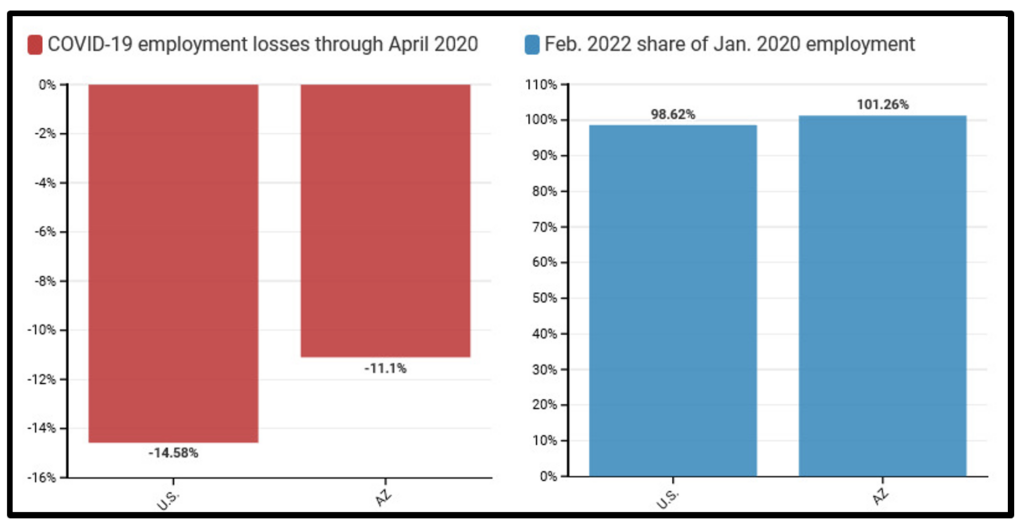Arizona added 11,700 jobs in February (+0.4%) and the Unemployment Rate declined by 0.1 percentage points to 3.6%. Since April 2020, the State has added over 376,500 jobs and regained 101.3% of its pandemic-related job losses. Arizona added over 1,000 new manufacturing jobs last month, and the sector is at 103% of its pre-pandemic level of employment.
Key Findings—Arizona February 2022 Employment Data (BLS CES Survey[i])
- Arizona added 11,700 total nonfarm jobs in February (a monthly change of 0.4% for a total year-on-year change of 4.5%).
- The state surpassed its pre-pandemic peak level of jobs in November 2021 – making it only the fifth state at the time to have done so.
- However, the State remains about 139,400 jobs below its 2017-2019 trend, and based on current growth rates will not achieve that level until mid 2023.
- Arizona’s labor market has outperformed the United States throughout the pandemic years – losing fewer jobs than all but 10 other states during the 2020 recession and regaining lost jobs faster than all but 4 other states.
- Twelve states have employment levels above what they were at the start of the pandemic. Utah has the highest differential (+5.1%).
- Hourly wages in Arizona increased by 7.4% over the 12-months ending in February, versus a 5.1% average increase for the United States as a whole.
- Arizona had the 10th fastest wage gains in the country over the past year, and the average private sector is now making 9.1% more than they were prior to the pandemic.
- Inflation over the same period was 10.9% – meaning real average hourly wages were down (3.5%) over the past year.
A Deeper Dive into Arizona Industries

- Though the leisure and hospitality industry has led the recovery by adding 43,100 jobs between Feb. ‘21 and Feb. ‘22, it is still down 14,500 jobs relative to Feb. ‘20.
- Arts, entertainment, and recreation is down 9.5% (4,500 jobs).
- Accommodation and food services is down 3.4% (10,000 jobs).
- Manufacturing is up over 5,000 jobs relative to its pre-pandemic peak. Arizona added nearly 1,000 new manufacturing jobs in February alone and is the state with the fifth-fastest recovering manufacturing sector since Feb. 2020.
Arizona Labor Force Update
Arizona’s Labor Force Participation Rate (LFPR) ticked up slightly in February as 10,018 new individuals either found or began looking for work. There are now more than 3.5 million people in the state’s labor force – the highest it has ever been since the Bureau of Labor Statistics began keeping track in 1976.
Key Findings—Arizona February ‘22 Labor Force Data (FRED[ii], and IPUMS-CPS[iii])
- February’s LFPR increased slightly to 60.8%, but remains below its 2019 level of 62.2%.
- At the current population, this gap would equate to approximately 82,000 additional willing workers.
- However, even at a reduced participation rate, in-migration – Arizona added over 125,000 new residents during the pandemic – has surged the states labor force to its largest level ever.
- February’s unemployment rate fell by 0.1 percentage points, to 3.6%.
- This is the lowest Arizona unemployment rate since 2007 and a decline of 40% over the past 12 months.
- In February, the LFPR of Arizona women increased from 52.87% to 53.28%. It is now 4.99 percentage points below its pre-pandemic level.
- The national female LFPR decreased by .2 percentage points to 56.6%, which is 1.1 percentage points below its pre-pandemic level.
Prime-age, Older, and Retirement-age People in the Labor Force

- Since Jan. ’20, labor force participation rates have declined for both young and retirement-age workers, regardless of gender.
- While retirement-age males exhibited the largest decline in participation in Arizona’s labor force during the pandemic, prime-age females were the second-largest contributor, and the participation rate of that demographic remains 4.63% below pre-pandemic levels.
© 2022 Common Sense Institute
[i] https://data.bls.gov/cgi-bin/dsrv?sm
[ii] https://fred.stlouisfed.org/
[iii] https://cps.ipums.org/cps/

